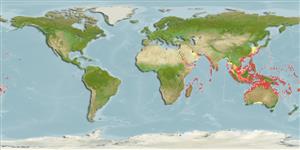Klassifizierung / Names
Namen | Synonyme | Catalog of Fishes (gen., sp.) | ITIS | CoL | WoRMS | Cloffa
Actinopterygii (Strahlenflosser) >
Perciformes (Perch-likes) >
Lethrinidae (Emperors or scavengers) > Lethrininae
Etymology: Lethrinus: Greek, lethrinia, a fish pertaining to genus Pagellus.
Lebensraum / Klimazone / Range
Ökologie
; seewasser; brackwasser riff-verbunden; standorttreu; tiefenbereich 10 - 75 m (Ref. 2295). Tropical, preferred 28°C (Ref. 107945); 34°N - 34°S, 25°E - 170°W
Indo-West Pacific: Red Sea, Persian Gulf and East Africa to southern Japan and Samoa. According to a genetic study (Ref. 28017), Lethrinus nebulosus and Lethrinus choerorynchus are two distinct species in Western Australia.
Length at first maturity / Size / Gewicht / Alter
Maturity: Lm 39.4, range 41 - ? cm
Max length : 87.0 cm TL Männchen/unbestimmt; (Ref. 47613); common length : 70.0 cm TL Männchen/unbestimmt; (Ref. 5450); max. veröff. Gewicht: 8.4 kg (Ref. 40637); max. veröff. Alter: 28 Jahre (Ref. 92312)
Rückenflossenstacheln (insgesamt): 10; Rückenflossenweichstrahlen (insgesamt): 9; Afterflossenstacheln 3; Afterflossenweichstrahlen: 8. Cheek without scales; 5-9 scales in supra temporal patch; inner surface of pectoral fin densely covered with scales; posterior angle of opercular fully scaled. Body color is yellowish or bronze, lighter below. Centers of many scales with a white or light blue spot. Sometimes irregular dark indistinct bars on sides and a square black blotch above pectoral fin bordering below the lateral line. Three blue streaks or series of blue spots radiate forward and ventrally from the eye. The fins are whitish or yellowish; the pelvic dusky, the edge of the dorsal fin is reddish. TL/SL relationship (cm): TL = 1.70 +1.24. Juveniles variable with blotches or stripe and changes with habitat (Ref. 48635).
Inhabit coral reefs, coralline lagoons, seagrass beds, mangrove swamps, flat sand bottoms, and coastal rock areas. Adults solitary or in small schools; juveniles form large schools in shallow, sheltered sandy areas, also harbors where seagrasses, algae or sponge habitats are found at various depths. Feed on echinoderms, mollusks and crustaceans, and to some extent on polychaetes and fish. The reproductive nature of spangled emperors is uncertain, although they also may be protogynous hermaphrodites (Ref. 27260, 55367). However, recent study classified juvenile hermaphroditism for this species wherein transition from ovary to testis occurs before ovarian maturation, hence, no true sex-reversal in the sense of protogynous hermaphroditism is observed (Ref. 107020). May have a coppery or iodine taste or smell in the Indian Ocean (Ref. 2295, 11888). It has been shown that this species can survive for long periods in salinities as low as 10 parts per thousand and therefore it is a potential estuarine aquaculture species (Ref. 2295). Utilized as a food fish.
The reproductive nature of spangled emperors is uncertain,. Though they also may be protogynous hermaphrodites (Ref. 27260), a study on the Great Barrier Reef (Ref. 27264) found no clear evidence of sex change in spangled emperors within the size range 17-54 cm (Ref. 6390). Gonochorism is inferred for this species as sizes of males and females overlapped and male gonad morphology is typical of secondarily derived testes (Ref. 103751). Recent study classified juvenile hermaphroditism for this species wherein transition from ovary to testis occurs before ovarian maturation, hence, no true sex-reversal is observed (Ref. 107020).
In the aquarium, pursuit of a female with a slightly swollen abdomen by a male signifies the start of mating. The male uses its mouth to bump and push the female's abdomen. Then eggs and sperm are released at the water surface (Ref. 58706).
Carpenter, K.E. and G.R. Allen, 1989. FAO Species Catalogue. Vol. 9. Emperor fishes and large-eye breams of the world (family Lethrinidae). An annotated and illustrated catalogue of lethrinid species known to date. FAO Fish. Synop. 125(9):118 p. Rome: FAO. (Ref. 2295)
IUCN Rote Liste Status (Ref. 115185)
CITES (Ref. 94142)
Not Evaluated
Bedrohung für Menschen
Reports of ciguatera poisoning (Ref. 31637)
Nutzung durch Menschen
Fischereien: hoch kommerziell; Aquakultur: kommerziell; Sportfisch: ja
Tools
Zusatzinformationen
Download XML
Internet Quellen
Estimates of some properties based on models
Phylogenetic diversity index (Ref.
82805): PD
50 = 0.5000 [Uniqueness, from 0.5 = low to 2.0 = high].
Bayesian length-weight: a=0.01660 (0.01374 - 0.02005), b=2.99 (2.95 - 3.03), in cm Total Length, based on LWR estimates for this species (Ref.
93245).
Trophic Level (Ref.
69278): 3.8 ±0.2 se; Based on diet studies.
Widerstandsfähigkeit (Ref.
69278): niedrig, Verdopplung der Population dauert 4,5 - 14 Jahre. (K=0.09-0.16; tm=4-9; tmax=27).
Prior r = 0.42, 2 SD range = 0.2 - 0.92, log(r) = -0.87, SD log(r) = 0.39, Based on: 20 K, 10 tgen, 5 tmax, records
Verwundbarkeit (Ref.
59153): Moderate to high vulnerability (47 of 100) .
